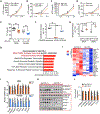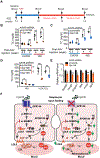GPR146 Deficiency Protects against Hypercholesterolemia and Atherosclerosis
- PMID: 31778654
- PMCID: PMC6889877
- DOI: 10.1016/j.cell.2019.10.034
GPR146 Deficiency Protects against Hypercholesterolemia and Atherosclerosis
Abstract
Although human genetic studies have implicated many susceptible genes associated with plasma lipid levels, their physiological and molecular functions are not fully characterized. Here we demonstrate that orphan G protein-coupled receptor 146 (GPR146) promotes activity of hepatic sterol regulatory element binding protein 2 (SREBP2) through activation of the extracellular signal-regulated kinase (ERK) signaling pathway, thereby regulating hepatic very low-density lipoprotein (VLDL) secretion, and subsequently circulating low-density lipoprotein cholesterol (LDL-C) and triglycerides (TG) levels. Remarkably, GPR146 deficiency reduces plasma cholesterol levels substantially in both wild-type and LDL receptor (LDLR)-deficient mice. Finally, aortic atherosclerotic lesions are reduced by 90% and 70%, respectively, in male and female LDLR-deficient mice upon GPR146 depletion. Taken together, these findings outline a regulatory role for the GPR146/ERK axis in systemic cholesterol metabolism and suggest that GPR146 inhibition could be an effective strategy to reduce plasma cholesterol levels and atherosclerosis.
Keywords: ERK1/2; SREBP2 pathway; atherosclerosis; hypercholesterolemia; orphan G protein-coupled receptor 146.
Copyright © 2019 Elsevier Inc. All rights reserved.
Conflict of interest statement
DECLARATION OF INTERESTS
C.A.C. is a founder of CRISPR Therapeutics and Sana Biotechnology. S.K. is a founder of Maze Therapeutics, Verve Therapeutics, and San Therapeutics.
Figures







Comment in
-
GPR146 is a potential new therapeutic target for lipid lowering.Nat Rev Cardiol. 2020 Mar;17(3):132-133. doi: 10.1038/s41569-019-0328-5. Nat Rev Cardiol. 2020. PMID: 31848468 No abstract available.
References
-
- Adiels M, Olofsson SO, Taskinen MR, and Boren J (2008). Overproduction of very low-density lipoproteins is the hallmark of the dyslipidemia in the metabolic syndrome. Arterioscler Thromb Vasc Biol 28, 1225–1236. - PubMed
-
- Arito M, Horiba T, Hachimura S, Inoue J, and Sato R (2008). Growth factor-induced phosphorylation of sterol regulatory element-binding proteins inhibits sumoylation, thereby stimulating the expression of their target genes, low density lipoprotein uptake, and lipid synthesis. J Biol Chem 283, 15224–15231. - PMC - PubMed
-
- Barrows BR, and Parks EJ (2006). Contributions of different fatty acid sources to very low-density lipoprotein-triacylglycerol in the fasted and fed states. J Clin Endocrinol Metab 91, 1446–1452. - PubMed
Publication types
MeSH terms
Substances
Grants and funding
LinkOut - more resources
Full Text Sources
Other Literature Sources
Medical
Molecular Biology Databases
Research Materials
Miscellaneous

